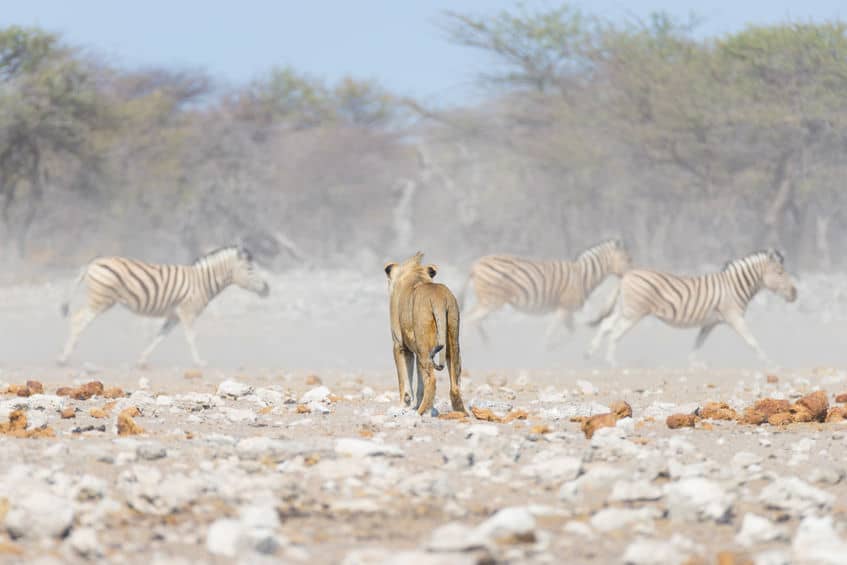One of the most breathtaking experiences you can have on an African safari is seeing a lion chasing a zebra. But have you ever wondered whether lions or zebras can actually run faster? And what if I told you that top speed is not at all everything?
Lions can run significantly faster than zebras. Lions have a top speed of 50 mph (80 km/h) and zebras have a top speed of 40 mph (64 km/h), however, since zebras are incredibly agile and lions spend tremendous amounts of energy when hunting, zebras are often able to escape if the chase lasts longer than about a minute.
As you can see, lions have a significantly higher top speed than zebras and should be able to catch them easily. It is, however, not at all that simple since zebras have much more endurance. Keep reading to get a more detailed explanation of whether lions or zebras are faster and why top speed isn’t everything.

Are Lions or Zebras Faster?
They are two of the most iconic and well-known African animals and thousands of safari tourists travel to Africa every year to try to spot them.
A Lion’s top speed is about 25% higher than a zebra’s. At 50 mph (80 km/h) vs. 40 mph (64 km/h), a lion should easily be able to catch a zebra but since lions are so large and heavy, they spend tremendous amounts of energy when hunting and zebras can often escape if they have not been caught within a minute.
Both lions and zebras are fast but speed is not everything and even though the predator can run a fair bit faster than the prey in this scenario, catching a zebra is not always an easy task for a lion.
Zebras are more agile and have significantly more endurance than lions. Lions will overheat quickly when running at or near their top speed so if a zebra survives the initial attack from a lion, it will often be able to escape.
Zebras can also run for a much longer period of time than lions so when a lion has chosen a zebra as its hunting target, the best strategy for the lion is to utilize some of the cat skills and abilities it has
When lions hunt alone, they rely on stealth, and their ability to sneak up on unsuspecting animals can mean the difference between a successful hunt and going hungry. When the lion is close to its target, it will leap forward in an attempt to catch its prey immediately but if it fails, a high-speed chase is imminent.
Lions do not always hunt alone. In fact, they usually stay in groups (called prides) consisting of anywhere between 2-40 lions.
When lions hunt together, they rely less on speed and more on their ability to sneak up on an unsuspecting target from all directions until the prey animal is surrounded and has no way of escaping.
As I have already talked about, speed is not everything and just because a lion is faster than a zebra on short distances, zebras are actually often able to get away and if they survive the lion’s initial attack, they just have to avoid getting caught for about a minute before the lion will be forced to give up. This is not always easy though.
Even though zebras are often able to escape, a meeting with a lion (and especially more lions) is extremely dangerous and is, unfortunately for the zebra, also often deadly.
Zebras may not be as fast as lions but they have more endurance and can actually sometimes be seen traveling hundreds of miles to find the best sources of grass and water.
These extremely long walks are often referred to as the great migration and are not only done by zebras but also other African animals such as wildebeests.
Take a look at this 1-minute video where you can see some completely incredible shots of a great migration where a large group of zebras migrates from the Chobe River to Makgadikgadi Pans in Botswana.
Now that we know that lions are significantly faster than zebras, let’s dive into some of the things zebras do to defend themselves and avoid getting caught by lions.
What do Zebras do for Protection Against Lions?
There is no doubt that a meeting with a lion can be a deadly event for a zebra and the more lions there are, the worse chances the zebra has of escaping.
Zebras do, however, have several strategies they use to reduce the risk of being hunted by lions and other predators.
The most important thing zebras do for protection against predators is staying in groups with other zebras. When zebras are under attack, the strongest zebras form a defensive circle around the weaker zebras to protect them. Zebras bite and kick enemies and their kick can be so strong that they can kill a lion.
Staying in a group (called a dazzle) provides much more protection than staying alone since it is much more dangerous for predators to attack large groups than solitary animals.
As a general rule, lions will go after zebras that have been separated from their group since they are not only less dangerous but also much easier to catch.
As mentioned, zebras will try to kick and bite their enemies to drive them away. Occasionally, male zebras also fight individually and will also kick and bite each other.
Zebras often also stay in groups with other large herbivores such as wildebeests or giraffes since it can provide additional protection and benefit all of the animals. Of course, this requires areas with much richer sources of food and water but if those criteria are met, grouping up with other animals is an excellent way of increasing their safety.
Another thing zebras do to increase their safety is to have at least one member of the dazzle be on lookout while the rest of them eat.
Zebras’ primary source of food is grass so when they eat, they keep their heads close to the ground. This inhibits their ability to look out for predators so when a dazzle of zebras is eating, they take turns so there will always be at least one zebra looking out for predators, ready to warn the others in case of danger.
Zebras also have a couple of excellent tricks for staying safe (or safer) when they sleep.
To increase their safety when they sleep, zebras will take turns and there will always be at least one zebra awake to look for predators. Zebras can lock their joints and often sleep while standing since this allows them to be ready to take off immediately in case of danger.
In either case, when zebras are eating or sleeping, the zebra (or zebras) that are on the lookout will make a distinct noise to warn the others in case of danger.
This may already seem impressive enough but there are even more strategies zebras can utilize to reduce the risk of becoming a meal for a predator.
Because of their stripes, zebras staying close together will often blend and make it difficult for a predator to distinguish between them. In addition to that, when zebras are being chased by predators, they sometimes run in zig-zag to make it harder for the predators to catch them.
If you found this post interesting, you can find more posts about lions on this link and zebras on this link.
Recommended Children’s Book About African Wildlife
If you have kids who like African wildlife and are looking for a book to read with them, or if you are interested in an easy-to-read book full of fascinating information and great photos, I can recommend a great book that I bought recently.
The book I want to recommend is called The Ultimate Book of African Animals by National Geographic Kids. When I first ordered it, I didn’t know what to expect, but I was very pleasantly surprised when I opened it.
The book contains so much fun and interesting information about all our favorite animals from Africa and a lot you probably didn’t even know existed. From tiny lizards to massive mammals, this book covers them all and has beautiful photos of the animals in action.
You can buy the book on Amazon at the link below. It is an affiliate link, so I will earn a commission if you choose to use it.

